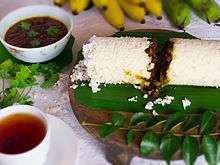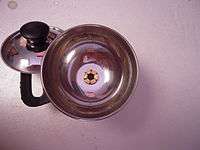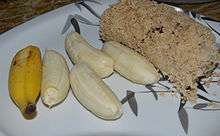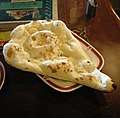Puttu
Pittu (Malayalam: പുട്ട്; Sinhala: පිට්ටු: Tamil: புட்டு) or puttu (pronounced [ˈputtu]) is a breakfast dish eaten in the South Indian states of Kerala, Tamil Nadu and parts of Karnataka, as well as Sri Lanka. Puttu means "portioned" in Malayalam. It is made of steamed cylinders of ground rice layered with coconut shavings, sometimes with a sweet or savory filling on the inside. Puttu is served hot with sweet side dishes such as palm sugar or banana, or with curries such as dal, chickpea, mutton, fish or chicken. In Bhatkal, puttu is served with side dishes such as ghee and sugar or Paya.

.jpg) Pittu | |
| Course | Breakfast |
|---|---|
| Place of origin | India |
| Region or state | India (Tamil Nadu, Kerala, South Canara and Coorg regions of Karnataka), Sri Lanka, Singapore, Malaysia (as putu bambu), Indonesia (as kue putu) and Philippines (as puto bumbóng) |
| Main ingredients | Rice flour, coconut, salt |
Ingredients
Puttu principally consists of coarsely ground rice, grated coconut, little salt and water. It is often spiced with cumin, but may have other spices. The Sri Lankan variant is usually made with wheat flour or red rice-flour without cumin whereas the Bhatkal recipes have plain coconut or masala variant made with mutton or shrimp flavoured grated coconut. In Bangladesh, the outside is made of a mixture of rice flour and ground moong dal, while the filling is a mixture of coconut flakes and a type of caramelized sugar that is similar to dulce de leche. [1]
Preparation
Puttu is made by slowly adding water to ground rice until the correct texture is achieved. It is then spiced, formed and steamed with layers of grated coconut.
Puttu is generally cooked in a metal puttu kutti vessel with two sections. The lower section holds water and the upper section holds the puttu — where the rice mixture is inserted with layers of grated coconut. Perforated lids separate the sections to allow the steam to pass between them.
A number of alternative cooking vessels are used, such as traditional vessels where a perforated coconut shell is attached to a section of bamboo, or a chiratta puttu made of a coconut shell or of metal shaped similarly to a coconut shell.

Other types of cooking vessels include a pan similar to an idli pan with small holes in the bottom, pressure cookers and, mainly in the Malay Archipelago, hollow bamboo stalks.
Serving
Puttu is often served along with gravies, like fish curry, chicken curry or kadala (chickpea) curry, and papadum. Also plantain, jackfruit, mango or banana is commonly served with it. In southern kerala people eat puttu accompanied by sweet black coffee. In Tamil Nadu it is served with grated coconut with jaggery made of palm or sugar cane, or with sweetened coconut milk. In Sri Lanka, puttu is usually accompanied with tripe curry, fish or a meat curry, coconut milk and a sambol.
Variations

Some variations of puttu use other grains such as wheat flour, ragi (finger millet) flour, tapioca and corn flour. The layered filling of coconut can be replaced by other foods, such as egg curry or banana. Puttu prepared in a ball shape are called manipputtu. Puttu can also be made using bamboo rice.
Muslims in Kerala eat a version of puttu called irachiputti in which rice is layered with spice mincemeat.[2] Puttu is also very common in Mauritius. It is usually sold by hawkers and is served as a snack. It is often misspelled poutou and should be spelled putu in Mauritian creole.[3] The ingredients are the same; rice flour, sugar and desiccated coconut but cooked in metal cylinders.
Similar dishes
In Maritime Southeast Asia, there are numerous similar dessert dishes known as kue putu in Indonesian, putu bambu in Malay, and puto bumbóng in Tagalog. They vary by preparation and ingredients but are also steamed in bamboo tubes and are served with sugar and grated coconut.[4][5]
In Indonesia, kue putu is characteristically green due to the use of pandan flavoring. It is commonly found being sold by traveling vendor carts together with klepon, which is actually ball-shaped kue putu.[4]
In the Philippines, puto bumbóng is deep purple in color due to the use of a unique rice variety called pirurutong. They are culturally significant as a common traditional Christmas dessert.[6] Puto in the Philippines is also a general term for traditional steamed rice cakes.
World record attempt
In 2006, students of the Oriental school of Hotel Management in Wayanad in north Kerala made a 10 foot long puttu. They cooked the giant puttu in a specially designed 12 foot long aluminium mould, using 20 coconuts and 26 kg of powdered rice. It took about one and a half hours to cook.[7]
See also
- Tamil cuisine
- Cuisine of Kerala
- Sunga Pitha, Assamese dish similar to puttu
- Kue putu, Indonesia dish similar to puttu
- Puto, the Philippine version derived from puttu
- List of steamed foods
- Idli
References
- "BBC Indian Food Made Easy: Recipe for puttu", BBC, archived from the original on 24 December 2008, retrieved 13 August 2010
- Brien, Charmaine O' (2013). The Penguin Food Guide to India. Penguin UK. ISBN 978-93-5118-575-8.
- "Lalit". www.lalitmauritius.org.
- Anggara Mahendra (13 June 2013). "'Kue Putu' Steamed Green Cake". Baily Daily. Archived from the original on 15 June 2015. Retrieved 12 June 2015.
- Angelita M. del Mundo (1995). "Emerging Versions of Some Traditional Philippine Rice Food Products". In Harlan Walker (ed.). Disappearing Foods: Studies in Food and Dishes at Risk. Proceedings of the Oxford Symposium on Food and Cookery 1994. Prospect Books. p. 64. ISBN 9780907325628.
- Sastrillo, Berna. "The Search for the Best Puto Bumbong in Manila". ModernFilipina. Retrieved 5 December 2018.
- "Kerala's Hotel Management Students Cook Up World Record Puttu", Indiatourism, retrieved 22 October 2010
External links
| Wikimedia Commons has media related to Puttu. |
| Wikibooks Cookbook has a recipe/module on |


